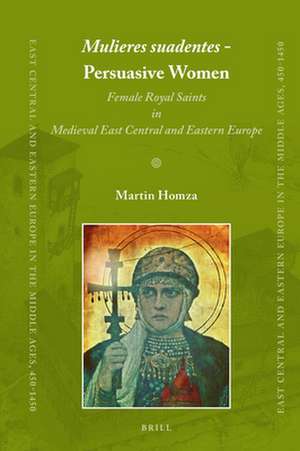<i>Mulieres suadentes</i> - Persuasive Women: Female Royal Saints in Medieval East Central and Eastern Europe: East Central and Eastern Europe in the Middle Ages, 450-1450, cartea 42
Autor Martin Homzaen Limba Engleză Hardback – 15 mar 2017
Din seria East Central and Eastern Europe in the Middle Ages, 450-1450
- 18%
 Preț: 800.46 lei
Preț: 800.46 lei - 18%
 Preț: 743.33 lei
Preț: 743.33 lei - 18%
 Preț: 1022.29 lei
Preț: 1022.29 lei - 18%
 Preț: 1176.15 lei
Preț: 1176.15 lei - 18%
 Preț: 731.25 lei
Preț: 731.25 lei - 18%
 Preț: 730.01 lei
Preț: 730.01 lei - 18%
 Preț: 893.05 lei
Preț: 893.05 lei - 18%
 Preț: 1010.45 lei
Preț: 1010.45 lei - 18%
 Preț: 1223.50 lei
Preț: 1223.50 lei - 18%
 Preț: 1048.15 lei
Preț: 1048.15 lei - 18%
 Preț: 940.83 lei
Preț: 940.83 lei - 18%
 Preț: 976.42 lei
Preț: 976.42 lei - 18%
 Preț: 940.07 lei
Preț: 940.07 lei - 18%
 Preț: 776.92 lei
Preț: 776.92 lei - 18%
 Preț: 648.08 lei
Preț: 648.08 lei - 18%
 Preț: 631.60 lei
Preț: 631.60 lei - 18%
 Preț: 709.54 lei
Preț: 709.54 lei - 18%
 Preț: 1055.16 lei
Preț: 1055.16 lei - 18%
 Preț: 1320.28 lei
Preț: 1320.28 lei - 18%
 Preț: 545.07 lei
Preț: 545.07 lei - 18%
 Preț: 814.51 lei
Preț: 814.51 lei - 18%
 Preț: 793.91 lei
Preț: 793.91 lei - 18%
 Preț: 695.49 lei
Preț: 695.49 lei - 18%
 Preț: 525.08 lei
Preț: 525.08 lei - 18%
 Preț: 707.77 lei
Preț: 707.77 lei - 18%
 Preț: 706.81 lei
Preț: 706.81 lei - 70%
 Preț: 625.11 lei
Preț: 625.11 lei - 18%
 Preț: 1540.16 lei
Preț: 1540.16 lei - 18%
 Preț: 851.46 lei
Preț: 851.46 lei - 18%
 Preț: 826.36 lei
Preț: 826.36 lei - 18%
 Preț: 817.49 lei
Preț: 817.49 lei - 18%
 Preț: 871.88 lei
Preț: 871.88 lei - 64%
 Preț: 715.27 lei
Preț: 715.27 lei - 18%
 Preț: 819.97 lei
Preț: 819.97 lei - 18%
 Preț: 849.51 lei
Preț: 849.51 lei - 18%
 Preț: 954.10 lei
Preț: 954.10 lei - 18%
 Preț: 1089.95 lei
Preț: 1089.95 lei - 15%
 Preț: 428.32 lei
Preț: 428.32 lei - 18%
 Preț: 730.47 lei
Preț: 730.47 lei - 18%
 Preț: 878.41 lei
Preț: 878.41 lei - 18%
 Preț: 730.01 lei
Preț: 730.01 lei - 18%
 Preț: 760.53 lei
Preț: 760.53 lei - 18%
 Preț: 636.93 lei
Preț: 636.93 lei - 18%
 Preț: 908.17 lei
Preț: 908.17 lei - 18%
 Preț: 882.32 lei
Preț: 882.32 lei - 18%
 Preț: 920.99 lei
Preț: 920.99 lei - 18%
 Preț: 577.99 lei
Preț: 577.99 lei - 18%
 Preț: 1323.50 lei
Preț: 1323.50 lei - 18%
 Preț: 1130.38 lei
Preț: 1130.38 lei
Preț: 670.69 lei
Preț vechi: 817.91 lei
-18% Nou
Puncte Express: 1006
Preț estimativ în valută:
128.35€ • 133.24$ • 107.02£
128.35€ • 133.24$ • 107.02£
Carte indisponibilă temporar
Doresc să fiu notificat când acest titlu va fi disponibil:
Se trimite...
Preluare comenzi: 021 569.72.76
Specificații
ISBN-13: 9789004314665
ISBN-10: 9004314660
Dimensiuni: 155 x 235 mm
Greutate: 0.52 kg
Editura: Brill
Colecția Brill
Seria East Central and Eastern Europe in the Middle Ages, 450-1450
ISBN-10: 9004314660
Dimensiuni: 155 x 235 mm
Greutate: 0.52 kg
Editura: Brill
Colecția Brill
Seria East Central and Eastern Europe in the Middle Ages, 450-1450
Notă biografică
Martin Homza, Prof. Dr. (1967), Faculty of Arts of Comenius University, Slovak Republic. He researches, and has published several monographs on, the early medieval history of East Central Europe. In 2012 he was awarded the Order of Merit of the Republic of Poland.
Recenzii
"This book examines the hagiography of female rulers in East-Central and Eastern Europe, mostly from the 10th to the 13th century. By focusing on the figures of St. Ludmila in Bohemia, St. Olga in Rus, and Princess Adelaide in the Kingdoms of Poland and Hungary, it shows how the commemoration of these women helped entrench both Christianity and the ruling dynasty in their respective lands. The book accomplishes a wider goal, however: by identifying the broader aspects of female royal saints and their cults, by tracing their origins and models in Byzantium, and by showing profound knowledge of such relevant comparative figures as St. Margaret of Scotland and St. Bertha of Kent, it contributes to the process of de-ghettoizing Eastern and East-Central Europe in European historiography." Nadieszda Kizenko, in JAHRBUCHER FUR GESCHICHTE OSTEUROPAS, 68 (2020)
